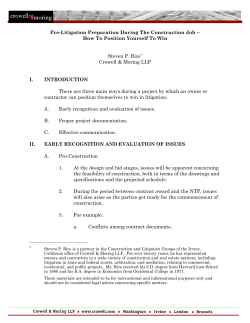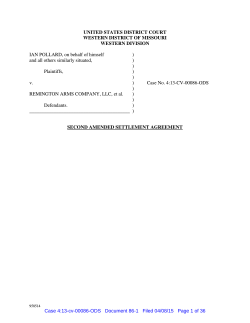
the PDF
E-Discovery Reducing Electronic Discovery Costs and Risks Through Litigation Readiness By Jeffrey Jacobs, Esq. r ecent court decisions imposing sanctions and holding both in-house and outside counsel responsible for poor electronic discovery practices make clear that all lawyers need to understand the basics of electronic discovery, or at least know when and how to engage colleagues, litigation support teams and service providers who are experts in the field. They should also know how their clients can use litigation readiness to reduce the costs and risks of electronic discovery. Litigation readiness starts with effective information management, on the so-called “left side” of the Electronic Discovery Reference Model (EDRM). A well-structured records retention policy and schedule, ensuring that information is kept only as long as required to meet legal and regulatory requirements, business purposes and of course compliance with any holds imposed for pending litigation or investigative proceedings, helps reduce the costs associated with storing unnecessary and outdated paper records and electronic data. When coupled with an effective email usage and retention policy, ideally enforced with an electronic tool that automatically deletes emails that have not been archived within a specified period of time, the amount of data that needs to be preserved, collected, processed and reviewed in responding to litigation or investigatory discovery requests can be significantly reduced, with accompanying cost savings. Under the amended FRCP, and many state and local rules, initial disclosure of copies or descriptions of relevant ESI and its sources is required within about three months after the beginning of a case. In order to be able to comply with this requirement within the requisite time frame, and also to avoid the risk of overlooking sources of potentially relevant information, it is helpful to have a data map identifying the major sources of ESI within an organization, including email and other messaging systems, electronic archives, collaborative tools and workspaces, corporate applications and databases, along with contact information for the business owners and users and the IT personnel responsible for managing or administering each one. This is also a convenient place to keep track of systemic retention (and deletion) and backup protocols, in case it is necessary to suspend them to implement a litigation hold. The data map should also include legacy or decommissioned systems that contain organizational information, even though those systems may not be considered reasonably accessible. Keeping the data map up to date requires regular communication with the IT department to make sure that changes are recorded as new systems and applications are brought online and old ones decommissioned. A number of electronic discovery decisions, including those in the Zubulake v. UBS and Qualcomm v. Broadcom cases, have stressed the importance of having a discovery response plan, ideally one that is developed and put in place before it needs to be activated in response to a specific litigation or investigatory matter. A good start involves creating a discovery response team, with representatives from legal, IT, HR, records, compliance, and other affected business units who will develop the response plan and be responsible for putting it into action when needed. It is also a good practice to select and enter into agreements with any service providers who may be needed, so that the terms, conditions and pricing will be in place before they are needed. The discovery response plan should include a documented, repeatable and legally defensible workflow, with detailed procedures for executing and documenting each step of the process. Given the number and cost of discovery sanctions imposed for inadequate preservation, the ability to impose a timely and effective litigation hold has to be at the center of any discovery response plan. The hold process should include the preparation of hold notices from templates, and methods for transmitting hold notices, receiving and documenting acknowledgments of receipt and compliance, providing periodic reminders of ongoing hold obligations, and ultimately releasing the hold. This can be done manually using spreadsheets, but keeping track of large numbers of custodians in large numbers of pending matters may require the use of legal hold tools or software, which may save personnel costs and automate documentation, thereby also reducing risk. This combination of litigation readiness elements – retention polices, data mapping, discovery response team and a documented discovery response plan – can all go a long way towards helping organizations reduce discovery costs and risks, and helping their counsel sleep better at night. Jeff Jacobs is DTI’s associate general counsel and also heads up DTI’s litigation readiness consulting practice, advising clients on records retention policies, data mapping, and the evaluation and development of discovery response plans. He is a frequent conference speaker and presenter of CLEs on a wide range of electronic discovery-related topics. www.dtiglobal.com september 2012 Attorney at Law Magazine® Metro Atlanta | 21
© Copyright 2025

















